This easy frittata recipe will be your new go-to for a healthy egg-based dish you can serve and enjoy any time of day. It keeps and reheats well, which makes it an excellent make-ahead meal. Today I’m sharing my 2 favorite versions, a garden vegetable frittata and a Mediterranean-inspired frittata. Make it exactly like I do, or play around with the recipe and make it a little differently every time!
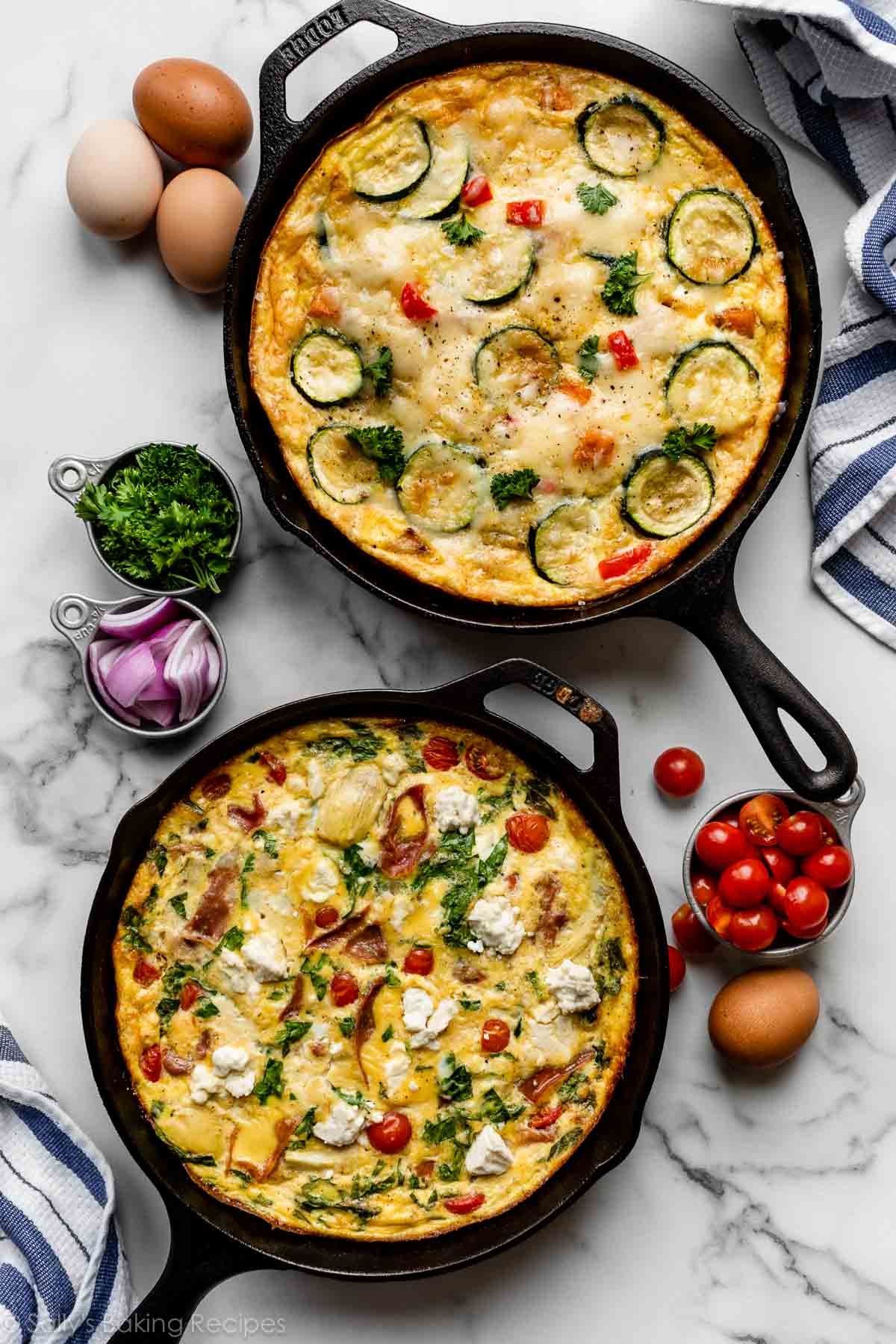
What Is a Frittata?
If you’ve never made one before, here’s a quick introduction to this delicious 1-pan meal. While it may resemble a crustless quiche, you’re using double the eggs and half the milk/cream, so the texture is more sturdy and less creamy—more like a thick, baked omelette.
You’ll begin cooking it on the stove, and then transfer it to the oven to bake. So a skillet that can go from stove to oven, such as a cast iron skillet, is necessary. More on this below.
Like any homemade omelette or breakfast casserole, you can customize the flavors of this frittata to your taste by choosing different add-ins. Make it exactly like one of the two ways I describe below, or play around with the recipe and discover your own favorite version!
To sum up, you’ll love this frittata recipe because it’s:
- Make-ahead friendly
- Can be served warm or at room temperature
- Packed with protein and vegetables
- Much easier and faster than making individual omelettes
- Infinitely customizable!
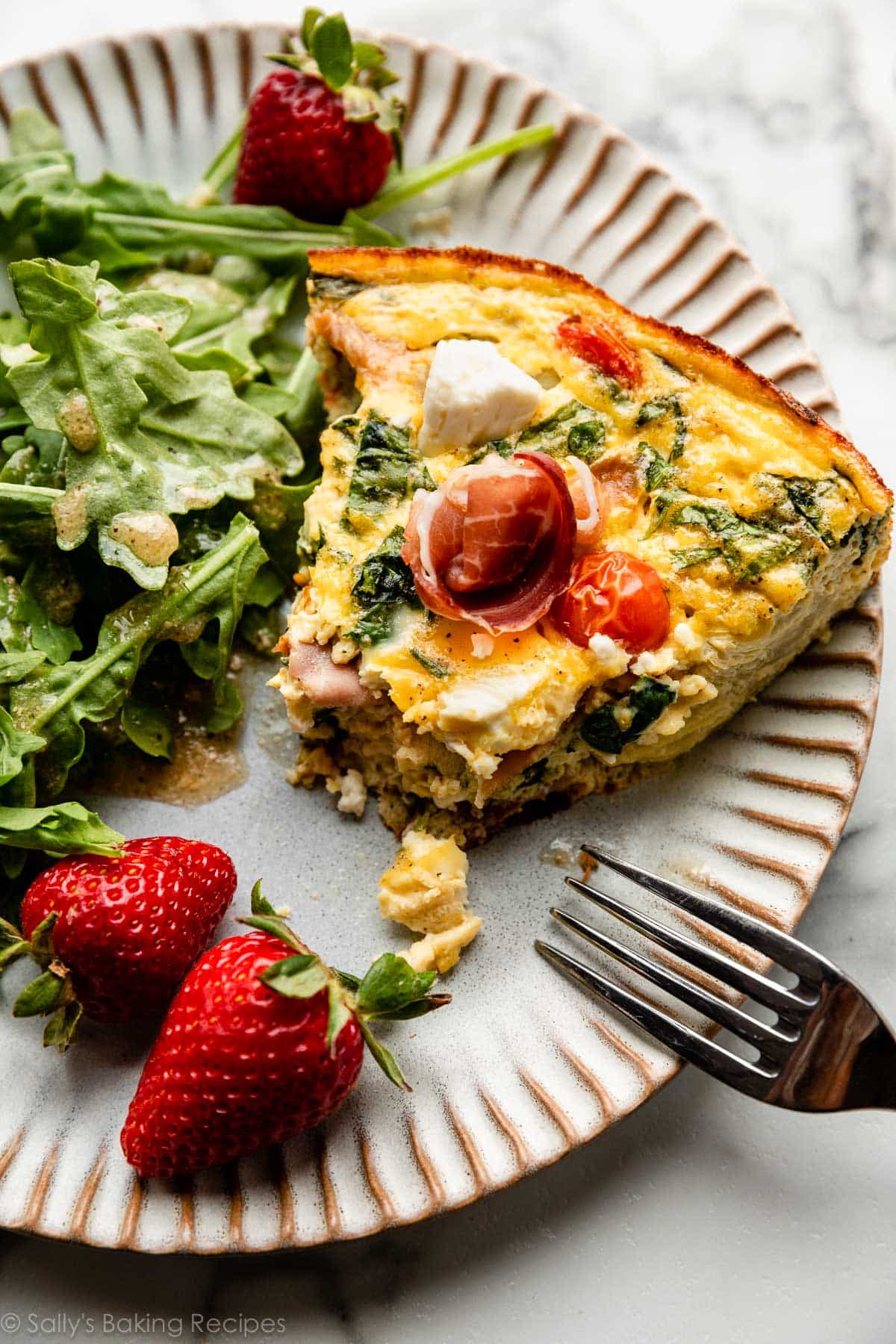
The ratio of eggs to milk is different: This frittata recipe uses 8 eggs and 1/2 cup milk, while my quiche recipe uses 4 eggs and 1 cup milk/cream. This means the texture of a frittata is more sturdy and solid, like an omelette; the texture of a quiche is creamier, and more custard-like. A quiche is usually baked in a pie crust; and a frittata starts in a skillet on the stovetop, and then finishes baking in the oven.
You could, but I don’t recommend using only egg whites because you will lose a lot of richness and flavor that the yolks provide. If you want to try it, use 2 whole eggs and 6 egg whites. Or try this lightened-up crustless veggie quiche.
Base Ingredients in This Frittata Recipe
Let’s start with the base ingredients of this frittata recipe. This is the starting point you can use every time, and then add in your selected vegetables and/or meats.
- 8 Large Eggs: The foundation of the frittata!
- 1/2 Cup Milk: Whole milk makes for the best texture, but it’s a small amount, so it’s not a big deal to use low-fat or nondairy milk instead. Use cream or half-and-half for a creamier texture.
- Salt & Pepper: These enhance all the other flavors you’ll add to your frittata.
- 1 Cup Cheese: You can use whatever type of cheese you enjoy best in an omelette. In the 2 frittata recipes detailed below, we’re using shredded sharp cheddar and crumbled feta.
- Garlic: Mince 2 cloves and cook it in some olive oil to give the frittata a flavorful start.
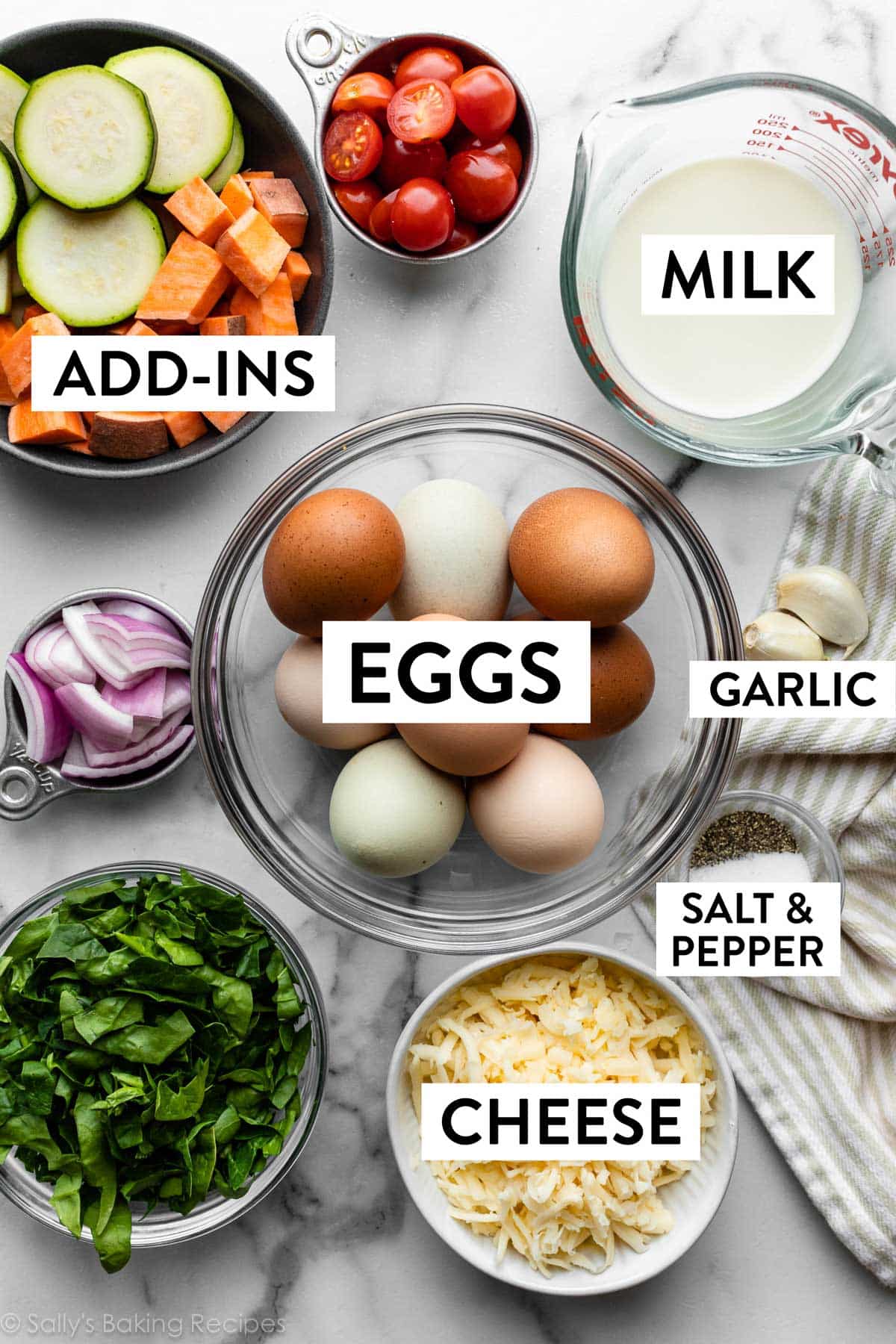
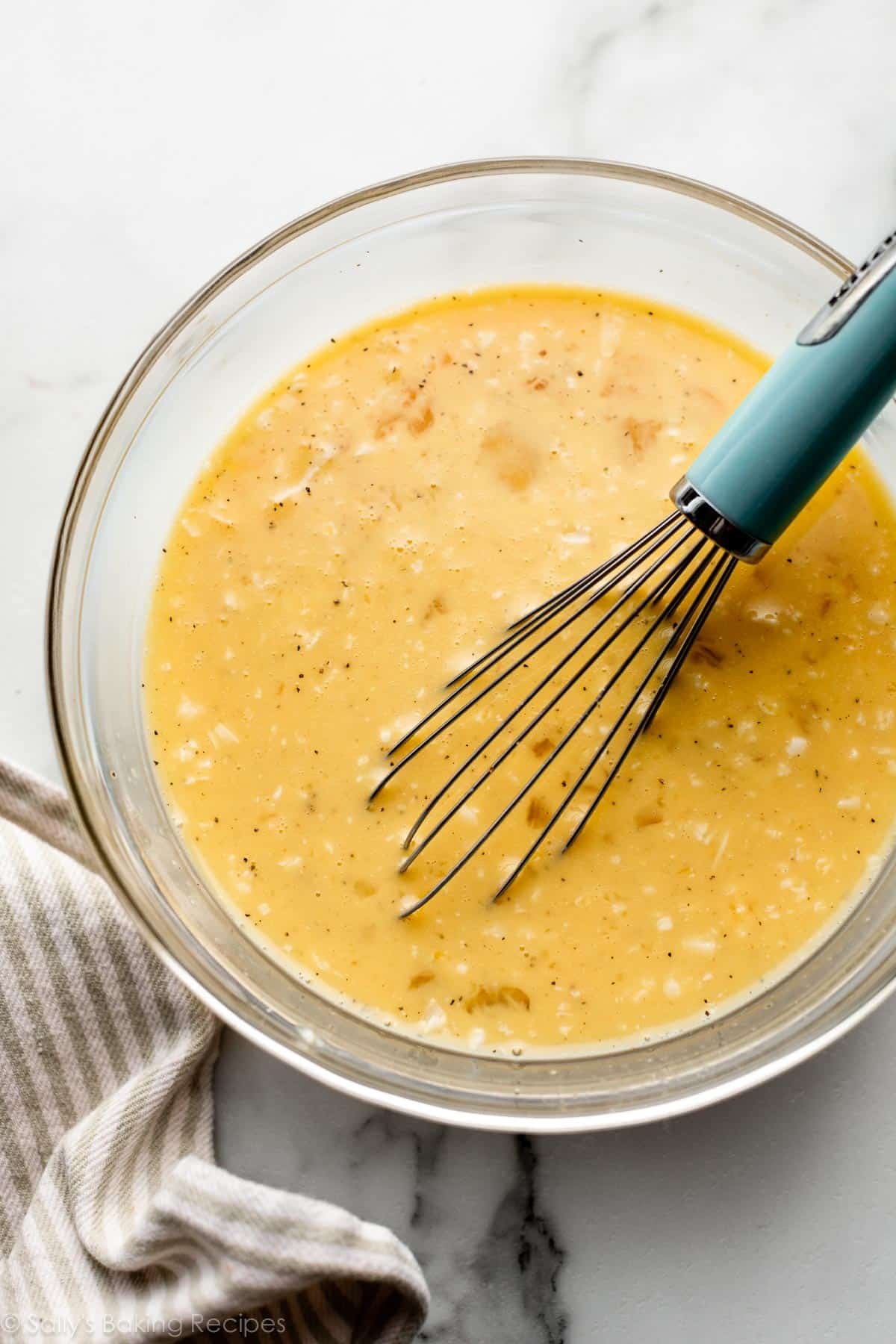
Just like with my recipes for quiche and breakfast casserole, you can adapt this frittata recipe to your taste, but if you’d like some inspiration, here are my 2 favorite versions:
Garden Vegetable Frittata
This version comes from team member, Beth. She usually roasts the vegetables in the oven first, but we decided to cut down on that step to see if we could make the recipe quicker… and it worked! So for this garden vegetable frittata, you’ll cook the vegetables in the skillet to soften them a bit before you pour in the egg mixture.
Here’s what we include:
- Red Onion: Slice half a red onion and add it to the pan with the garlic.
- Sweet Potato: Chop up a sweet potato, and cook it with the onion and garlic.
- Red Bell Pepper: Diced red pepper adds a pop of color, but yellow or orange peppers taste just as good!
- Zucchini: Slice a small zucchini, and halve any larger rounds.
- Shredded Sharp Cheddar Cheese: In recipe testing, mild cheddar’s flavor got lost in here. Use a sharper cheese for the best-tasting vegetable frittata.
After the vegetables have softened on the stove, pour the egg mixture on top and let it cook for about 5 minutes before transferring to the oven:
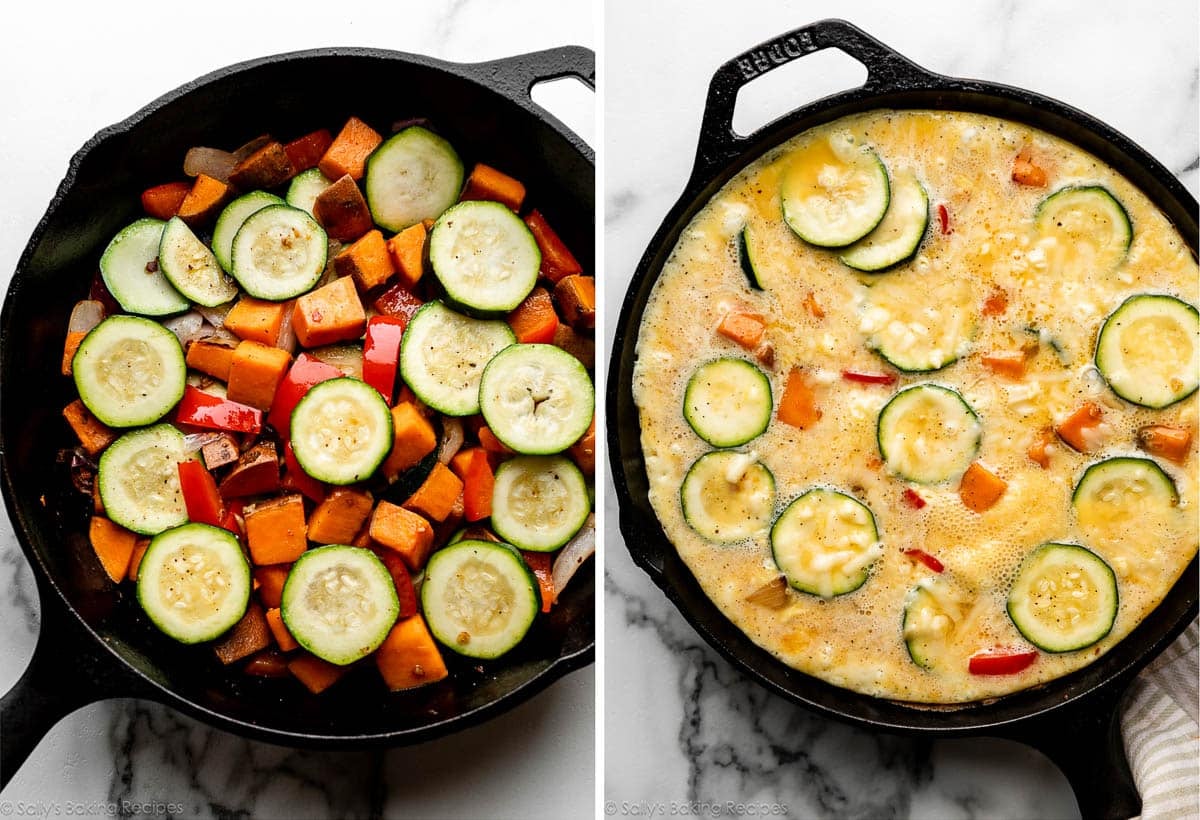
Mediterranean-Inspired Frittata Recipe
Frittata is Italian, and so naturally, Mediterranean flavors work wonderfully in here. There’s no need to pre-cook these already-soft ingredients, so you can add everything right into the egg mixture. Here’s what I include:
- Artichokes: I use canned quartered artichoke hearts, and drain them well.
- Fresh Spinach: Give the leaves a rough chop.
- Cherry Tomatoes: Halved cherry tomatoes add color as well as flavor.
- Prosciutto: This salty, thin-sliced ham is dry-cured, so no pre-cooking is required. Slice into bite-size pieces. Feel free to omit for a vegetarian frittata.
- Crumbled Feta Cheese: I love the creamy, salty tang of feta, but a shredded hard Italian cheese, such as parmigiano reggiano or pecorino romano, would also be delicious in this Mediterranean-inspired frittata.
Start on the Stove & Finish in the Oven
Just as I showed you above, a head-start on the stove “sets” the egg mixture which helps prevent a watery frittata. This is important because when you include vegetables with a high water content, such as zucchini and tomatoes, it’s necessary to cook off some of that moisture.
After about 5 minutes, the edges should be bubbling and beginning to set, and then you can move the skillet to the oven to bake:
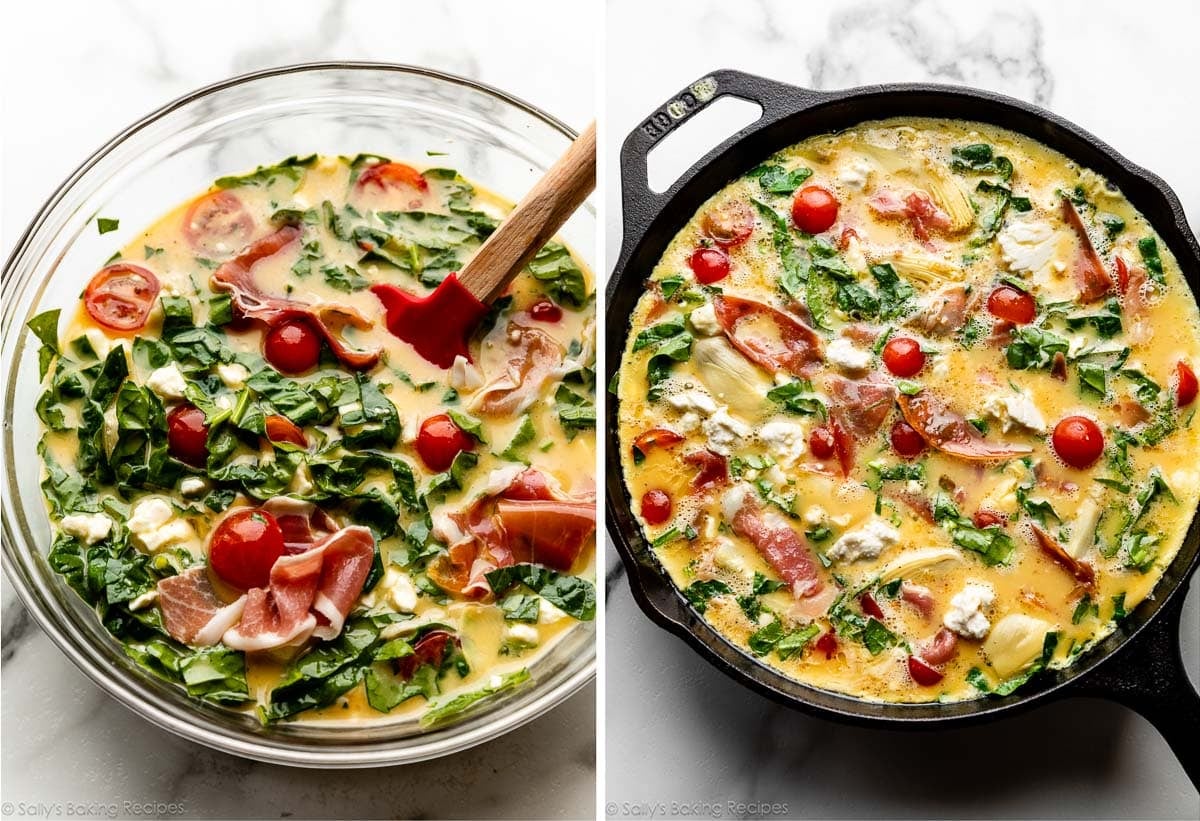
Now this is probably the hardest part! The pan is very hot and the mixture is still very liquid, so use 2 oven mitts and go slowly to transfer it super CARE-FULL-Y to the oven.
Bake for about 25–30 minutes, until the frittata is puffy and the center is no longer wobbly/wet. Let it cool for at least 10 minutes before you slice into it—the frittata will continue to set up thanks to the residual heat from the pan.
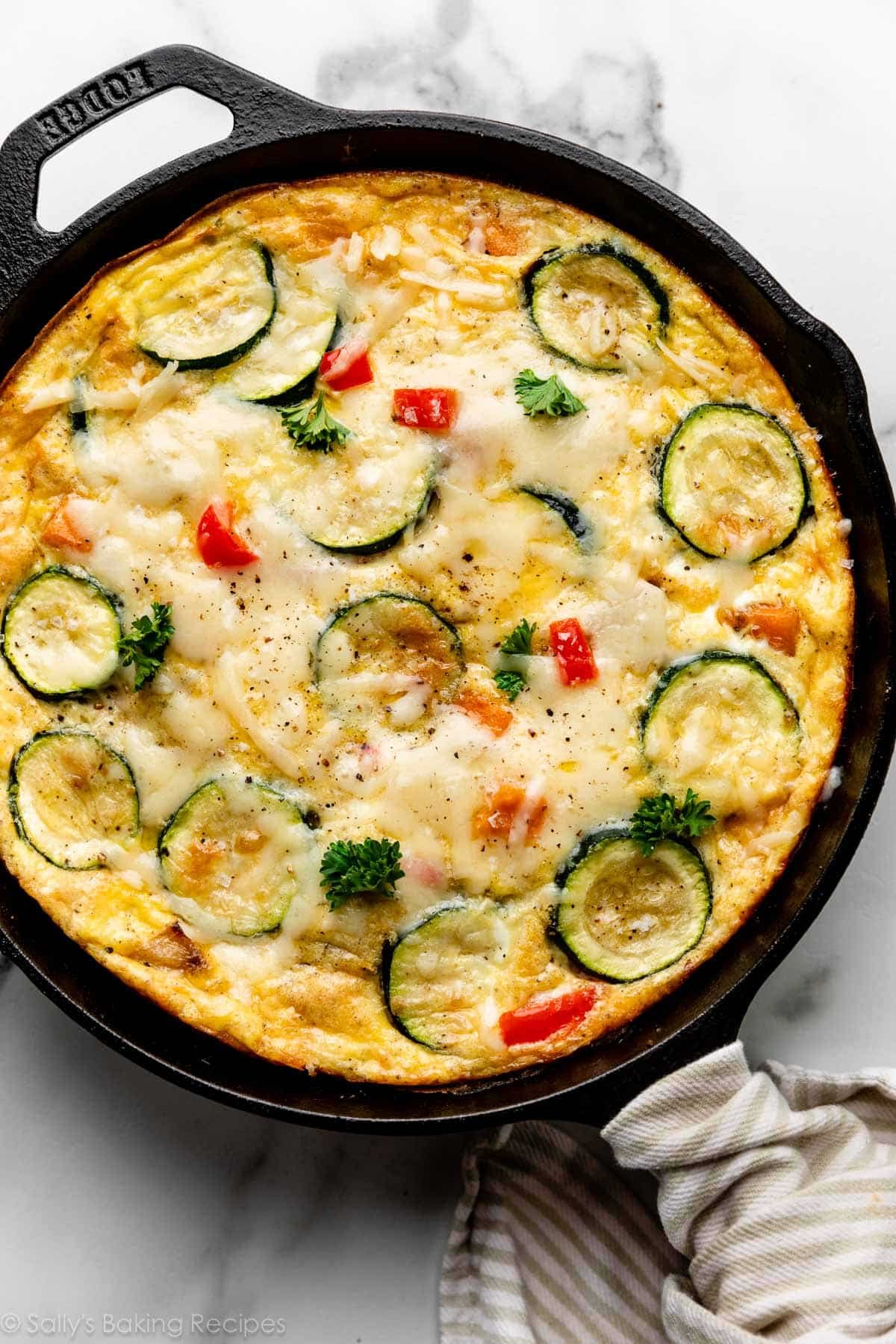
Best Pan for Making Frittata
Because you start the frittata on the stove, and then transfer it to the oven, a pan that can go safely from stovetop to oven is necessary. A seasoned cast iron skillet is perfect here.
This is the cast iron skillet I have, and I highly recommend it. It’s inexpensive, comes pre-seasoned, works on all types of cooktops, heats evenly, and is made to last a lifetime. (Not sponsored, just a true pan fan!)
This 10.25-inch-diameter, 2-inch-deep size is what I use for turkey pot pie, skillet cornbread, sea salt and herb rolls, bruschetta chicken, cornmeal cake, biscuits, and more. Talk about a useful pan to have in the kitchen! You can really use any 10 to 12-inch oven-safe skillet that’s about 2 inches deep.
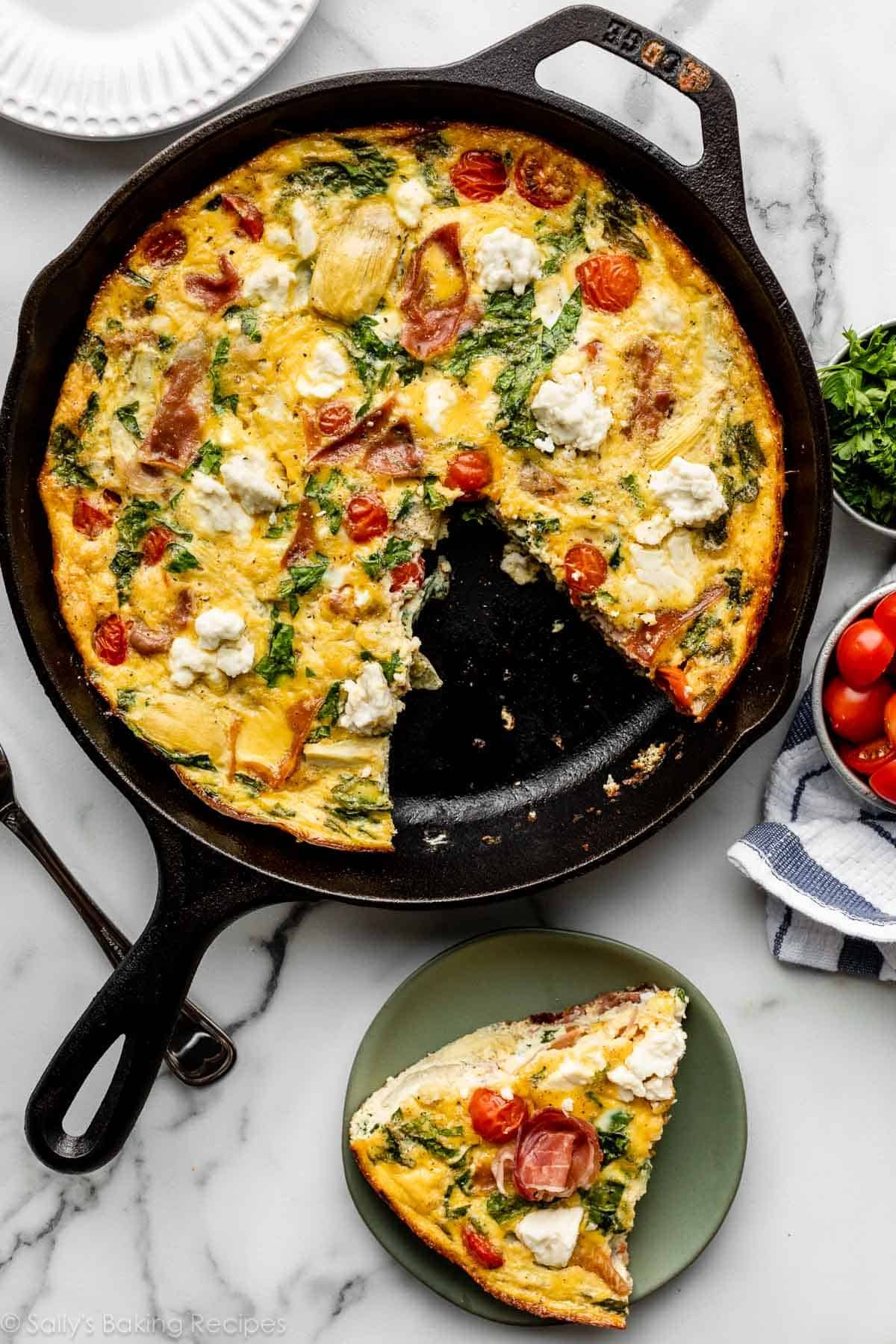
What to Serve With Frittata
Fruit and a fresh arugula salad are easy, healthy sides. Or, if you’re serving the frittata as part of a bigger brunch, it would plate nicely alongside any of these favorites:

Easy Frittata Recipe (Choose Your Add-Ins)
Prep Time: 20 minutes
Cook Time: 30 minutes
Total Time: 1 hour
Yield: serves 8
Category: Breakfast
Method: Baking
Cuisine: American
Description
This easy frittata recipe will be your new go-to for a healthy egg-based dish you can serve and enjoy any time of day. Below are my 2 favorite versions, a garden vegetable frittata and a Mediterranean-inspired frittata. Follow the recipes exactly, or play around with the add-ins and make it a little differently every time!
Base Frittata Recipe
Variation #1: Garden Vegetable
Variation #2: Mediterranean-Inspired
Instructions
- Preheat oven to 375°F (191°C).
- In a medium bowl, preferably one with a pour spout, whisk together the eggs, milk, salt, and pepper. Fold in about 3/4 cup of the cheese, reserving the rest for topping. Set aside.
- Heat olive oil in a 2-inch deep, 10-12-inch wide oven-safe skillet over medium heat. Add the garlic and cook, stirring, for about 30–60 seconds (don’t let it brown). Continue with either version below.
For the Garden Vegetable Frittata:
- Add the red onion and sweet potato to the pan with the garlic. Cook for 5 minutes, stirring occasionally, until they begin to soften. Add the red peppers and zucchini, and sprinkle with salt and pepper. Cook for another 5 minutes, stirring occasionally.
- Pour the egg mixture over the vegetables and cook for 5 minutes, without stirring, until bubbling/starting to set around the edges. Sprinkle the remaining 1/4 cup cheese on top.
- Carefully transfer the skillet to the center rack of the oven, and bake for 22–26 minutes, or until the frittata is puffy and the center no longer wobbles/looks wet.
- Let it cool for at least 10 minutes before slicing and serving. It will continue to set as it cools.
For the Mediterranean-Inspired Frittata:
- Fold in the spinach, tomatoes, artichoke hearts, and prosciutto into the egg-and-cheese mixture.
- Pour the egg mixture into the pan with the cooked garlic and cook for 5 minutes, without stirring, until bubbling/starting to set around the edges. Sprinkle the remaining 1/4 cup cheese on top.
- Carefully transfer the skillet to the center rack of the oven, and bake for 22–26 minutes, until the frittata is puffy and the center no longer wobbles/looks wet.
- Transfer the skillet to a wire rack, and let it cool for at least 10 minutes before slicing and serving. It will continue to set as it cools.
Notes
- Storage Instructions: Cover leftover frittata and store in the refrigerator for up to 5 days. Microwave to reheat or place slices on a lined baking sheet and bake, covered, in a 350°F (177°C) oven for 5-10 minutes or until warmed throughout.
- Freezing & Reheating Instructions: It’s best to freeze the fully baked and cooled frittata (unless you want to freeze the partially cooked egg mixture in your skillet, which for best results, I do not recommend). Cool baked frittata completely, cut into slices, transfer slices to a freezer-friendly container, and cover tightly. Freeze for up to 3 months. When ready to eat, thaw in the refrigerator, and microwave to reheat or place slices on a lined baking sheet and bake, covered, in a 350°F (177°C) oven for 5-10 minutes or until warmed throughout.
- Special Tools (affiliate links): Mixing Bowls With Pour Spout | Whisk | Cast Iron Skillet or any oven-safe skillet that’s 2 inches deep and 10-12-inches wide
- Milk: Whole milk provides the best taste and texture, but you can substitute lower-fat or nondairy milk in a pinch. Using heavy cream or half-and-half will make for a creamier texture.
- Other add-ins: Stick with 2 to 3 cups total add-ins, and use the base recipe as the starting point for your own variation. You can pre-cook any vegetables on the stove with the olive oil and garlic like you do in the Garden Vegetable version. Regular white potato, broccoli, mushrooms, and/or asparagus are also great additions. Cook until softened before adding the egg mixture.
- Can I add other meats? Yes, absolutely. You can add cooked diced ham, sliced chicken sausage, and/or shredded or chopped chicken. Fold into the egg-and-cheese mixture or feel free to brown a bit with the garlic/vegetables on the stove before adding the egg mixture.
Nutrition
- Serving Size: 1 slice vegetable frittata
- Calories: 179
- Sugar: 2.3 g
- Sodium: 340.4 mg
- Fat: 12.1 g
- Carbohydrates: 6.3 g
- Protein: 11.1 g
- Cholesterol: 202.6 mg
